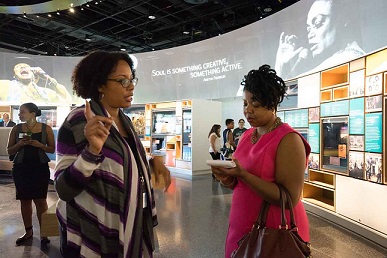

“Sometimes a collection tells you the story that it needs to tell,” says Joanne Hyppolite, a curator of the Cultural Expressions gallery at the new National Museum of African American History and Culture. Hyppolite and co-curator Deborah Mack were given a task that no person has ever taken on before. In the finite space of one unusual gallery, they were asked to plan, collect and display an exhibition on the impossibly huge subject of the cultural expressions of African-Americans.
Their canvas was a round room on the museum’s fourth floor. In it, case displays are organized in concentric circles beneath a high orbit of curved video screens projecting dance, theater, poetry and other performances. This doesn’t look like any other place, anywhere.

Clothes, hairstyles, painting, carving, cooking, gesture, dance, language etc. Nearly everything that human beings do is a cultural expression. Somehow, Hyppolite and Mack had to boil down hundreds of years of this vast subect and synthesize it into a single, circular gallery, where millions of people would come to walk through and learn from, while also perhaps seeing something of themselves. They would do this by choosing objects and arranging them into stories.
“One of the major ideas in this exhibition is that African-American culture is an everyday thing,” says Mack. “It doesn’t have to be removed—it is very much a part of it. People grow up with it and take it for granted. At least some of these collections were celebrating the everyday, not the celebrity.” Objects used to style black women’s hair throughout the 20th century were thus grouped into a small collection. Devices that straightened or curled. Things remembered from mothers and grandmothers.
“Our museum has a policy that we have to see the object in person before accepting it,” says Hyppolite of the process it took to travel the country and meet with the people in their homes and in their churches, at their jobs and in their community spaces to gather the material of this exhibition. “You are in someone’s kitchen, in their work place,” adds Mack.
In these intimate places, Hyppolite and Mack asked strangers for family heirlooms. Styling tools and cookbooks and an oyster basket and more. It was time for these ordinary objects from the lives of black families to take on a role far beyond what they had originally been made for. It took little convincing.
“People feel honored,” says Hyppolite. “They understand the connection that this item has to the rest of the culture.”
“In every case they understood,” said Mack. “We didn’t have to explain that connection. They understood it. When we said what the story line was, it was like ‘of course.’ There would be a question of whether to donate it or to loan it. But they could often finish our sentences.”
The two curators approached Mary Jackson, a renowned basket weaver from Charleston, South Carolina, who has both preserved and elevated the art of basket-weaving that was brought to the region by West African slaves and maintained by the unique Gullah culture of South Carolina and Georgia’s coasts.
“We commissioned two sweetgrass baskets from her,” says Mack. “She comes out of a historical community. She is a recognized artist. . . I went to meet her and told her what this story line is about and talked about what she would make that reflected the story line and values. She suggested that she create what was a working man’s basket for transporting rice in the 18th century. But it was a working basket. It looks very much like the historic form.”
That was the first of two baskets that Jackson wove for the Museum.
“Her other piece is sculptural, says Mack. “It is an innovative form that nobody else can create. That was her 21st-century looking-forward form. Art for art’s sake as opposed to art for function. I met with her several times, once in her studio where she does a lot of work now and another time with her daughter and husband. She knows what she is doing and where it comes from. She is a fourth-generation basket maker… She is a humbling presence. A great person.”
“Then there are the people you meet through their work alone and the stories about their work, since they lived so long ago,” says Hyppolite. “Like the story of Hercules, George Washington’s cook. The foodways exhibit is talking about the diversity of food styles. It’s not just soul food. You read about Hercules and you find that he is planning state diners, a celebrated French chef. His work is so appreciated that he is brought to Philadelphia. And he ran away.”
“He was a celebrity chef in his own day,” agreed Mack. “George Washington was able to avoid emancipating his staff by moving them from Mount Vernon to Philadelphia [the temporary capitol of the United States at the time] but moving them back and forth every six months. One of the times he was about to send his staff back, Hercules disappeared and was never seen again. Washington sent bounty hunters after him, posted rewards, but he was never heard from. Even today.”
Read more: Smithsonian Magazine
